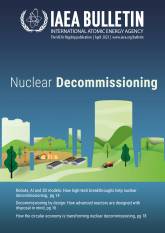
If you would like to learn more about the IAEA’s work, sign up for our weekly updates containing our most important news, multimedia and more.
Decommissioning is the last stage in the life cycle of a nuclear power plant. Planning for decommissioning begins at the design stage of the plant, to ensure that dismantling and associated waste management can be safely and effectively implemented without negatively impacting the environment. Once a nuclear power plant is permanently shut down, it transitions from a facility involving operational processes for electricity production, to one whose activities are associated with the preparation and implementation of decommissioning, including changes to organization and to plant safety systems. When dismantling is deferred, the facility is placed in a stable condition until dismantling occurs, while radioactivity levels naturally decay. The time taken between the permanent shutdown of a nuclear power plant and the completion of decommissioning, which can range from about a decade to 70 or more years, varies from country to country.
After decommissioning, the site is available for other social or economic purposes. This infographic illustrates the main activities in the decommissioning process.

